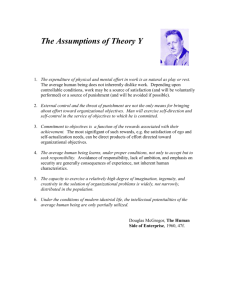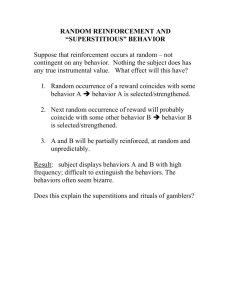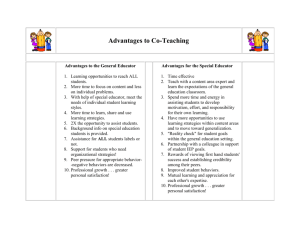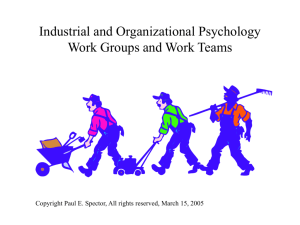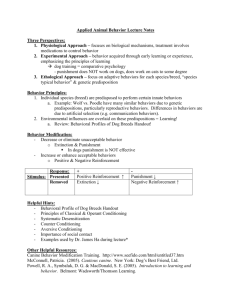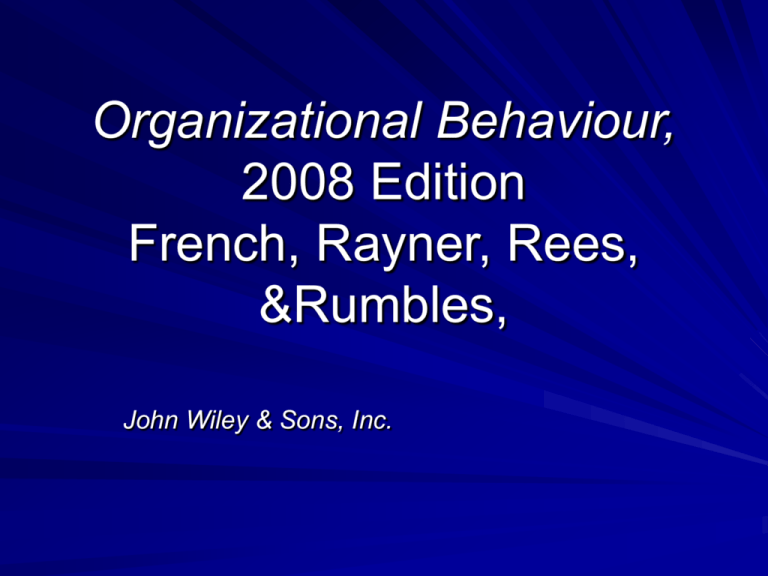
Organizational Behaviour,
2008 Edition
French, Rayner, Rees,
&Rumbles,
John Wiley & Sons, Inc.
Chapter 1
Learning Objectives
Define organizational behavior (OB)
• Get acquainted with basic OB terminology
Describe what managers do
Understand why managers must know
about OB
Identify the three levels of analysis in OB
My Best Manager ex
What is an Organization?
An organization is a
collection of people
who work together
to achieve
individual and
organizational goals.
ORGANIZATIONAL
PERFORMANCE
Depends on the organizations’ ability to
attain organizational goals in an effective
and efficient manner.
Effectiveness : the degree to which the
organization achieves a stated goal
Efficiency : the use of minimal resources
to produce a desired volume of output.
What is Management?
Management is the
process of planning,
organizing, leading,
and controlling an
organization’s
resources to attain
organizational goals
in an effective and
efficient manner .
The Roles of Management
Decisional
Interpersonal
Prentice Hall, 2001
Informational
Chapter 1
7
Informational roles = maintain &
develop information network
The monitor = seeking current information
from many sources.
The disseminator = transmits information
to others both inside and outside the
organization.
The spokesperson = to provide official
statements to people outside the
organization about company policies,
actions, or plans.
Interpersonal roles pertain to
relationships with others
The figurehead = ceremonial activities
The leader = motivation, communication,
and influence of subordinates.
The liaison = development of a web of
relationships both inside and outside the
organization.
Decisional roles = make choice
requiring conceptual & human skills.
The entrepreneurial = initiation of
change.
The resource allocator = how to allocate
resources to achieve outcomes.
The negotiator = negotiating and
bargaining for unit of responsibility.
The disturbance handler = resolving
conflicts between subordinates or other
departments.
http://www.ba.metu.edu.tr/user/pinar
My Best Manager
Make a list of the attributes that describe
the best manager you ever worked for.
In groups of 4-5, share your lists.
As a group create one list that combines
all the unique attributes.
Each group will read its list to class.
Managerial Skills
Conceptual Skills: The ability to
analyze and diagnose a situation
and distinguish between cause
and effect.
Human Skills: The ability to
understand, work with, lead, and
control the behavior of other
people and groups.
Technical Skills: Job-specific
knowledge and techniques.
The Management Pyramid
Top
Managers
Middle
Managers
First-line
Managers
What is Organizational Behavior?
Organizational
behavior (OB) is the
study of factors that
affect how
individuals and
groups act in
organizations and
how organizations
manage their
environments.
Insert Figure 1.1 here
Organizational Behavior Terminology
Dependent Variables: Factors that
you want to explain and that are
affected by other factors.
Productivity
Absenteeism
The
Dependent
Variables
Turnover
Job Satisfaction
Prentice Hall, 2001
Chapter 1
18
Organizational Behavior
Terminology
Independent Variables: Determinants of
dependent factors
Individual level
Group level
Organization level
Independent Variables
Individual
Group
Organization
•Biographical Traits
•Communication
•Culture
•Personality
•Other Groups
•Structure
•Values & Attitudes
•Conflict
•Design
•Ability
•Power & Politics
•Technology
•Perception
•Group Structure
•Work Processes
•Motivation
•Work Teams
•Selection Processes
•Individual Learning
•Leadership
•Training Programs
•Decision Making
•Decision Making
•Appraisal Practices
Prentice Hall, 2001
Chapter 1
20
OB Formula
Behavior, Attitudes = f( person, environment)
Chapter 2
Individual differences
Agenda
Explain role of nature and nurture in determining
personality
Discuss the Big Five Personality Model
Explain individual personality factors
Explain role of the situation
Identify three types of ability
Discuss values
Discuss 3 components of attitudes
Discuss attitude-behavior relationship
The Individual Performance
Equation
Job performance
=
Individual attributes
X
Work effort
X
Organizational support
Individual Performance Factors
Individual attributes
Work effort
Organizational support
Demographic Differences
Gender
Age
Ethnic background
Stereotyping
Prejudice in our lives ex on page W91
Differences in Abilities
Cognitive abilities
Physical abilities
Emotional intelligence
The Ability-Job Fit
Abilities of the
employee
Requirements of
the job
Prentice Hall, 2001
Chapter 2
28
EQ test
Strongly disagree 1
Disagree 2
Neither agree nor disagree 3
Agree 4
Strongly agree 5
For question 2 & 3: deduct your response
from 6
Then calculate the sum of your responses
Personality Differences
Personality is the overall profile or
combination of traits that characterize the
unique nature of a person.
Personality Determinants
The nature/nurture controversy is the
argument over whether personality is
determined by heredity, or genetic
endowment, or by one’s environment.
Key Dimensions of Personality
Extroversion – introversion
Conscientiousness
Agreeableness
Emotional stability
Openness to experience
Surgency means extroversion
Adjustment means emotional stability
Problem-Solving Styles
Sensation type
Intuitive type
Feeling type
Thinking type
Occupational Matches
Locus of Control
The extent to which people feel able to
affect their lives
Internal locus of control
External locus of control
Authoritarianism / Dogmatism
Authoritarianism
Dogmatism
Type A vs. Type B Personality
Type A: A person who
has an intense desire to
achieve, is extremely
competitive, and has a
strong sense of urgency.
Type B: A person who
tends to be easygoing and
relaxed.
Machiavellianism
Machiavellians are people who view and
manipulate others for purely personal gain.
Self-Concept
The concept individuals have of
themselves as physical, social and
spiritual or moral beings.
Self-Esteem
The extent to which
people have pride in
themselves and their
capabilities.
– Can be high or low
– Not situation specific
Self-Monitoring
The extent to which
people try to control the
way they present
themselves to others.
– Can be high or low
Individual Differences
Recruitment and employment conditions
Education, training and development
Rewards and promotions
Personality-Job Fit
Personalities among individuals differ
Demands of jobs differ
Matching personality and job leads to
higher satisfaction and lower turnover.
Advice to Managers
Realize and accept that some workers are more likely than
others to be positive and enthusiastic because of their
personalities. Similarly, realize and accept that some workers
are more likely than others to complain and experience stress
because of their personalities.
Provide an extra measure of direct supervision to workers who
don’t take the initiative to solve problems on their own and
always seem to blame someone or something else when things
go wrong.
Provide additional encouragement and support to workers with
low self-esteem who tend to belittle themselves and question
their abilities.
Realize and accept that Type A individuals can be difficult to
get along with and sometimes have a hard time working in
teams.
Let subordinates who seem overly concerned about other
people liking them know that sometimes it is necessary to give
honest feedback and be constructively critical (such as when
supervising others).
Values
Values are global beliefs that guide actions
and judgments across a variety of
situations.
Classification Schemes
Rokeach
– Terminal
– Instrumental
Allport
–
–
–
–
–
–
Theoretical
Economic
Aesthetic
Social
Political
Religious
Meglino & Associates
–
–
–
–
Achievement
Helping and concern for others
Honesty
Fairness
Work Values
A worker’s personal convictions about
what outcomes one should expect from
work and how one should behave at
work.
Values can be intrinsic (i.e., related to the
nature of work itself) or extrinsic (i.e.,
related to the consequences of work).
Intrinsic vs. Extrinsic Work Values
Intrinsic Values
Interesting work
Challenging work
Learning new things
Making important
contributions
Responsibility and
autonomy
Being creative
Extrinsic Values
High pay
Job security
Job benefits
Status in wider
community
Social contacts
Time with family
Time for hobbies
Results of the Beutell and Brenner (1986)
Study (1 is the strongest ranking)
Item
Provides job security
Provides the opportunity to earn
a high income
Permits advancement/responsibility
Is respected by other people
Provides comfortable working
conditions
Rewards good performance with
recognition
Encourages continued
development…
Is intellectually stimulating
Men
2.5
Women
2.0
2.5
4.0
5.5
5.0
6.5
3.0
7.0
4.0
5.5
8.5
8.0
9.0
6.5
8.5
Advice to Managers
Do not assume that most workers have
strong intrinsic work values just because you
do.
Realize that any attempt you make to
improve attitudes, motivation, or
performance will be most effective when the
change you implement is consistent with
workers’ values.
Values and national culture.
Cultures vary in underlying patterns of
values and attitudes.
Hofstede’s five dimensions of national
culture:
– Power distance.
– Uncertainty avoidance.
– Individualism-collectivism.
– Masculinity-femininity.
– Long-term/short-term orientation.
Values and national culture.
Power distance.
– The willingness of a culture to accept status
and power differences among members.
– Respect for hierarchy and rank in
organizations.
– Example of a high power distance culture —
Indonesia.
– Example of a low power distance culture —
Sweden.
Values and national culture.
Uncertainty avoidance.
– The cultural tendency toward discomfort with
risk and ambiguity.
– Preference for structured versus unstructured
organizational situations.
– Example of a high uncertainty avoidance
culture — France.
– Example of a low uncertainty avoidance
culture — Hong Kong.
Values and national culture.
Individualism-collectivism.
– The cultural tendency to emphasize individual
or group interests.
– Preferences for working individually or in
groups.
– Example of an individualistic culture — United
States.
– Example of a collectivist culture — Mexico.
Values and national culture.
Masculinity-femininity.
– The tendency of a culture to value stereotypical
masculine or feminine traits.
– Emphasizes competition/assertiveness versus
interpersonal sensitivity/relationships.
– Example of a masculine culture — Japan.
– Example of a feminine culture — Thailand.
Values and national culture.
Long-term/short-term orientation.
– The tendency of a culture to emphasize
future-oriented values versus present-oriented
values.
– Adoption of long-term or short-term
performance horizons.
– Example of a long-term orientation culture —
South Korea.
– Example of a short-term orientation culture —
United States.
Values and national culture
Attitudes
A predisposition to respond in a positive or
negative way to someone or something in
your environment.
Components of Attitudes
Cognitive components
Affective components
Behavioral components
Components of Attitudes
Importance
of the Elements
Cognitive
Dissonance
Degree of
Personal Influence
Rewards
Involved
Types of Attitudes
Job satisfaction: General attitude toward
one’s job
Organizational commitment: a state in
which one identifies with a particular
organization and its goals and wishes to
maintain membership
Attitudes and Behavior
Attitudes and behavior
Attitudes and cognitive consistency
Job satisfaction as an attitude
Facets of Job Satisfaction
The work
Quality of supervision
Relationship with co-workers
Promotion opportunities
Pay
Job Satisfaction and Workplace
Behavior
Performance
Absenteeism
Turnover
Relationship between
Satisfaction and Performance
Satisfaction causes performance?
Performance causes satisfaction?
Rewards cause both performance and
satisfaction
Potential Consequences
of Job Satisfaction
Performance: Satisfied workers are only
slightly more likely to perform at a higher level
than dissatisfied workers.
– Satisfaction is most likely to affect work behaviors
when workers are free to vary their behaviors and
when a worker’s attitude is relevant to the
behavior in question.
Absenteeism: Satisfied workers are less
likely to be absent than dissatisfied workers.
Turnover: Satisfied workers are less likely to
leave the organization than dissatisfied
workers.
Potential Consequences
of Job Satisfaction
Organizational citizenship behavior (OCB):
Satisfied workers are more likely to engage in
this behavior than dissatisfied workers.
– OCB: Behavior that is above and beyond the call
of duty but is nonetheless necessary for
organizational survival and effectiveness
Helping coworkers, spreading goodwill
Worker well-being: Satisfied workers are
more likely to have strong well-being than
dissatisfied workers.
– Worker well-being: How happy, healthy, and
prosperous workers are
Advice to Managers
Realize that some workers are going to be more satisfied than
others with the same job simply because they have different
personalities and work values. Also realize that you can take steps
to increase levels of job satisfaction because it is determined not
only by personality but also by the work situation.
Try to place newcomers in work groups whose members are
satisfied with their jobs.
Ask workers what facets of their jobs are important to them, and do
what you can to ensure that they are satisfied with these facets.
Because job satisfaction has the potential to impact workers’
behaviors in organizations and their well-being, use existing
measurement scales to periodically survey your subordinates’
levels of job satisfaction. When levels of job satisfaction are low,
follow the advice in the preceding step.
Recognize that workers’ evaluations of job facets, not what you
think about them, determine how satisfied workers are and that
changing some facets may have longer-lasting effects on job
satisfaction than changing others.
Advice to Managers
Do not assume that poor performers are dissatisfied with their jobs or that
good performers are satisfied with their jobs.
Do not assume that workers who are absent are dissatisfied or that they
were not motivated to come to work. Absence is also a function of ability
to attend.
Manage absenteeism. Don’t try to eliminate it, and keep in mind that a
certain level of absence is often functional for workers and organizations.
Realize that turnover has both costs and benefits for an organization and
that you need to evaluate both. In particular, before becoming concerned
about worker turnover, examine the performance levels of those who quit.
If workers do only what they are told and rarely, if ever, exhibit
organizational citizenship behavior, measure their levels of job
satisfaction, identify the job facets they are dissatisfied with, and make
changes where possible.
Even if job satisfaction does not seem to have an effect on important
behaviors in your organization, keep in mind that it is an important factor
in worker well-being.
Doc Marten’s Case
What specific things does Doc Marten’s do
to raise levels of
– Job satisfaction
– Organizational commitment?
Notice how Doc Marten’s manages
differences in values.
Agenda
Define perception
Identify factors that affect perception
Discuss perceptual distortions
Discuss attribution
Discuss impression management
Perception
Perception
People are not entirely objective
information processors
– Perception not necessarily the same as reality
– Perceptions of two people are not necessarily
the same when describing the same event
Perception is biased in a number of
predictable ways
Factors Influencing Perception
The perceiver
The setting
The perceived
Factors Influencing Perception
Stages of Perception
Attention and selection
Organization
Interpretation
Retrieval
Perceptual Distortions
Stereotypes
Halo effects
Selective perception
Projection
Advice to Managers
Be careful not to jump to conclusions about coworkers,
superiors, and subordinates simply because they appear to
fit your preexisting thoughts and opinions. Wait to form your
opinions until you have gathered enough information to
make a fair judgment.
Make sure your perceptions of workers are based on their
skills, capabilities, accomplishments, on-the-job behaviors,
and levels of job performance.
Do not allow your perceptions to be influenced by
characteristics of a target (such as race, age, and gender)
that are unrelated to job behaviors and performance.
Try to treat organizational members who stand out from
others the same as you treat those who do not stand out.
Advice to Managers
Be careful not to let your first impressions have too
strong an effect on your perceptions of others. Avoid
categorizing workers until you have sufficient
information to form an accurate perception.
When evaluating or interviewing a series of individuals,
do not let your evaluations of preceding individuals
influence your ratings of those that follow.
Be careful not to be lenient in your perceptions of
people who are similar to you and overly harsh to
those who are dissimilar to you.
Attribution Theory
Observation
Interpretation
Attribution
of Cause
High
External
Low
Internal
High
External
Low
Internal
High
Internal
Low
External
Distinctiveness
Attribution
Theory and
Individual
Consensus
Behavior
Consistency
Prentice Hall, 2001
Chapter 5
84
Fundamental Attribution Error
Tendency to explain other people’s
behavior with internal attributions and to
underemphasize plausible situational
causes of the behavior in question
Inhibits managers from fixing situational
problems
Self-Serving Bias
The tendency to deny personal
responsibility for poor performance but to
accept personal responsibility for high
performance when explaining our own
behavior
Advice to Managers
Make sure your attributions for other people’s behavior
are as accurate as possible.
Consider external factors that may be responsible for
other people’s behavior, such as inadequate resources
or supplies, an exceptionally difficult task, or chance
occurrences.
Consider internal factors that may be responsible for
your own behavior, such as your personality, your
strengths and weaknesses, and your level of
motivation.
Be aware of the tendency in yourself and in others to
take credit for successes and avoid blame for errors.
Managing Perceptions
Self-awareness
Seek information
Be empathic
Avoid common perceptual distortions
Impression Management Tactics
Behavioral
Matching
The target of perception matches
his or her behavior to that of the
perceiver.
A subordinate tries to imitate her boss’s
behavior by being modest and soft-spoken
because her boss is modest and soft-spoken.
SelfPromotion
The target tries to present herself
or himself in as positive a light as
possible.
A worker reminds his boss about his past
accomplishments and associates with coworkers who are evaluated highly.
Conforming The target follows agreed-upon
to Situational rules for behavior in the
organization.
Norms
Appreciating
or Flattering
Others
Being
Consistent
A worker stays late every night even if she has
completed all of her assignments because
staying late is one of the norms of her
organization.
The target compliments the perceiver. This tactic works best when
flattery is not extreme and when it
involves a dimension important
to the perceiver.
A coworker compliments a manager on his
excellent handling of a troublesome employee.
The target’s beliefs and behaviors
are consistent. There is agreement
between the target’s verbal and
nonverbal behaviors.
A subordinate delivering a message to his boss
looks the boss straight in the eye and has a
sincere expression on his face.
Chapter 3
Learning
Reinforcement Theory
Present behavior can be explained by past
environmental responses B = F(C).
Thorndike’s Law of Effect:
Behavior that results in a pleasant outcome is
likely to be repeated; behavior that results in an
unpleasant outcome is not likely to be repeated.
• Behavior can be controlled by manipulating its
consequences (called operant conditioning)
• Organizational Behavior Modification
OB Mod Strategies
Positive reinforcement
Negative reinforcement
Punishment
Extinction
Reinforcement
Positive Reinforcement: The administration
of positive consequences to workers who
perform desired behaviors.
– Pay, promotions, interesting work, praise,
awards
Negative Reinforcement: The removal of
negative consequences when workers
perform desired behaviors.
– Nagging, complaining
Advice to Managers:
Reinforcement
Administer rewards only when workers perform desired behaviors or
close approximations of them.
When using reinforcement, make sure you identify the right behaviors
to reinforce (those that help the organization achieve its goals).
Because job performance is likely to vary across workers, administer
rewards so that high-performing workers receive more rewards than
low-performing workers.
Do not assume that a given reward will function as a positive
reinforcer to all workers. Take individual preferences into account.
Make sure the consequences of a behavior are equal to the behavior.
Make sure that workers know what reinforcers are available for
desired behaviors. Don’t just assume that they know.
Extinction and Punishment
Extinction: Removing a consequence
that is currently reinforcing an undesirable
behavior in an effort to decrease the
probability that the behavior will occur
again in the future.
Punishment: Administering negative
consequences to workers who perform
undesirable behaviors in an effort to
decrease the probability that the behavior
will occur again in the future.
– Verbal reprimands, docking pay, loss of
privileges
Negative Reinforcement vs.
Punishment
These two concepts are often confused; however,
they differ from each other in two important ways.
First difference:
– Punishment reduces the probability of an undesired
behavior.
– Negative reinforcement increases the probability of a
desired behavior.
Second difference:
– Punishment involves administering a negative
consequence when an undesired behavior occurs.
– Negative reinforcement entails removing a negative
consequence when a desired behavior occurs.
Advice to Managers: Punishment
Remember that all behaviors, good and bad, are performed because
they are reinforced in some way. Undesired behaviors can be
eliminated by determining how the behavior is being reinforced and
removing the reinforcer.
When feasible, use extinction rather than punishment to eliminate
undesired behaviors.
When you use punishment, make sure workers know exactly why
they are being punished.
Make sure the chosen negative consequence is indeed a punishment
for the individual in question.
Downplay the emotional element in punishment, punish immediately
after the undesired behavior, and do not punish in front of others.
Chapter 4
Motivation theories
Agenda
Define motivation
Discuss link between motivation &
performance
Discuss link between motivation & rewards
Content/Need theories of motivation
Process theories of motivation
Reinforcement theory
Motivating the Workforce
Motivation to work refers to forces within
an individual that account for the level,
direction and persistence of effort
expended at work.
Motivation & Performance
What are the determinants of an individual’s
performance?
→Individual attributes - capacity to perform
→Organizational support - opportunity to
perform
→Work effort
Individual
Ability
Motivation
Work
Effort
Organizational
Support
Work
Performance
Motivation Theories
Content Theories: Focus on understanding
individual needs - what motivates an individual.
Process Theories: Focus on the thought
processes that give meaning to rewards and
influence behavior - how a person becomes
motivated.
Reinforcement Theory: Focuses on learning.
Content Perspectives
(Need Theory)
Assumption: People are motivated to satisfy
their needs; if we know what they need, we’ll
know how to motivate them.
Needs: Physiological or psychological
deficiencies that people feel some compulsion to
eliminate.
Maslow’s Hierarchy of Needs Theory
Alderfer’s ERG Theory
Acquired Needs Theory
Two Factor Theory
Maslow’s Hierarchy of Needs
Theory
Higher order needs
Lower order needs
Maslow’s Hierarchy of
Needs
Alderfer’s ERG Theory
Existence Needs: Basic needs for human
survival such as the need for food, water,
clothing, shelter, and a secure and safe
environment.
Relatedness Needs: The needs to have
good interpersonal relations, to share
thoughts and feelings, and to have open
two-way communication.
Growth Needs: The needs for selfdevelopment and creative and productive
work.
Advice to Managers
Do not assume that all workers are motivated by
the same needs or desires.
To determine what will motivate any given worker,
determine what needs that worker is trying to
satisfy on the job.
Make sure you have the ability to administer or
withhold consequences that will satisfy a worker’s
needs.
Structure work situations so that workers can
satisfy their needs by performing behaviors that
enable the organization to achieve its goals.
McClelland’s Acquired Needs
Theory
Need for achievement
Need for affiliation
Need for power
Acquired Needs Theory
Herzberg’s Two-factor Theory
Hygiene factors
Motivator factors
Hygiene Factors found in work
settings
Comparison of Content
Theories
Process Theories
Focus on thought processes that underlie
individual responses to work situations.
– Equity Theory
– Expectancy Theory
Equity Theory
Negative inequity
Positive inequity
The Equity Dynamic
Advice to Managers
Because inputs are likely to vary across workers,
outcomes should also vary. Do not give all workers at a
given level or holding the same job title the same level of
outcomes unless their inputs are identical.
Distribute outcomes to workers based on their inputs to
their jobs and the organization. Because underpayment
inequity or overpayment inequity can have negative
organizational consequences, strive to maintain equity for
maximum motivation.
Because it is the perception of equity or inequity that
drives motivation, frequently monitor and assess workers’
perceptions about relevant outcomes and inputs, as well
as their own standing on these outcomes and inputs.
Correct any inaccurate perceptions workers may have.
Realize that failure to recognize above-average levels of
inputs has major motivational implications.
Expectancy Theory
People will do….
…..what they can do….
…..when they want to.
Managerial Foundations of
Expectancy Theory
Managerial Implications of
Expectancy Theory
A manager must try to understand
individual thought processes, then actively
intervene in the work situation to influence
them.
Advice to Managers
Determine what outcomes your subordinates desire. More specifically,
identify outcomes that have high positive valence for your subordinates in
order to motivate them to perform at a high level.
Once you have identified desired outcomes, make sure that you have control
over them and can give them to subordinates or take them away when
warranted.
Let subordinates know that obtaining their desired outcomes depends on
their performing at a high level (raise instrumentalities). Administer the
highly valent outcomes only when subordinates perform at a high level (or
engage in desired organizational behaviors).
Do whatever you can to encourage workers to have high expectancies:
Express confidence in subordinates’ abilities, let them know that others like
themselves have been able to perform at a high level, and give them
guidance in terms of how to perform at a high level.
Periodically assess workers’ beliefs concerning expectancies and
instrumentalities and their valences for different outcomes by directly asking
them or administering a survey. Using these assessments, make different
outcomes available to workers, and clarify instrumentalities, or boost
expectancies when necessary.
Chapter 5
Goal Setting & Job Design
Goal Setting
The process of developing, negotiating
and formalizing objectives.
Locke’s research
A Goal-setting Framework
Source: Adapted from Edwin A. Locke and Gary P. Latham, ‘Work motivation and
satisfaction: Light at the end of the tunnel’, Psychological Science, vol. 1, no. 4
(July 1990), p. 244. Reprinted by permission of Blackwell Publishers.
The MBO Process
Job Design
Job Design involves the planning and
specification of job tasks, and the work
setting designated for their
accomplishment.
Alternative Job Design
Strategies
Job simplification
Job enlargement
Job rotation
Job enrichment
Job Simplification
Job simplification is standardizing work
procedures and employing people in
clearly defined and specialized tasks.
Job automation
Job Enlargement and
Job Rotation
Job Enlargement: combining two or more
tasks into one job
Job Rotation: periodically shifting workers
among jobs
Job Enrichment
The practice of building motivating factors
into job content
Vertical loading
Horizontal loading
A Continuum of Job Design
Strategies
Job Characteristics Theory
Skill variety
Task identity
Task significance
Autonomy
Job feedback
Individual differences:
moderators of job
characteristics theory
The five core job characteristics do
not affect all people in the same
way. There are three important
individual difference moderators:
– Growth-need strength
– Knowledge and skill
– Context satisfaction
Growth Needs and Core Job
Characteristics
Source: Adapted from J. Richard Hackman, Greg Oldham, Robert Janson and
Kenneth Purdy, ‘A new strategy for job enrichment, California Management Review,
vol. 17, no. 4 (1975), p. 60.
Socio-technical Job Design
The design of jobs to optimize the
relationship between the technology
system and the social system.
Q & A – Job Enrichment
Is it expensive?
Can it be applied to groups and
individuals?
Will people demand more pay?
What do the unions say?
Should everyone’s job be enriched?
Chapter 6
Groups & Teamwork
What is a Group?
Groups are collections of two or more
people who work with one another
regularly to achieve one or more common
goals.
Purpose of Groups in
Organizations
Meeting organizational needs
Meeting individual needs
Benefiting organizations and individuals
Key Concerns for
Managing Groups
Advantages of groups
Disadvantages of groups
Formal Groups
Permanent formal work groups
Temporary work groups
Informal Groups
Friendship groups
Interest groups
Groups and
Task Performance
Synergy The whole is different than the
sum of its parts.
Groups can make 2+2=5 or 2+2=3
Positive Synergy – “Two heads are
better than one.”
The creation of whole greater than sum of
its parts.
Groups accomplish more than the total of
their members’ individual capabilities.
Occurs when:
– A diverse set of skills is required.
– Division of labor and sharing of information
are required.
– Creativity and innovation are required.
Negative Synergy – “Too many cooks
spoil the broth.”
The creation of whole less than sum of its parts.
Social loafing (Ringelmann effect): The tendency of group
members to do less that they are capable of as individuals.
Ringlemann’s experiments – compared the results of
individual and group performance on a rope-pulling task.
–
–
–
–
Groups of 3 people – 2.5 times the solo rate.
Groups of 8 people – less than 4 times the solo rate.
Average productivity dropped as more people joined.
Replications of Ringelmann’s experiments – People tend not to
work hard as in groups as they would individually.
Why?
The relationship between an individual’s input and the
group’s output is unclear. In such situations individuals are
tempted become “free riders”.
Belief of inequity – individuals reduce their efforts to
reestablish equity.
Characteristics of
Group Effectiveness
Effective groups are groups that achieve
high levels of both task performance and
human resource maintenance.
Foundations of
Group Effectiveness
The better the group inputs, the better the
chance of group effectiveness.
Organizational Setting
Goals, reward systems and technologies
Cultures and structures
General Membership
Characteristics
Membership homogeneity/heterogeneity
Interpersonal compatibilities
Group size
Stages of Group Development
Forming
Storming
Norming
Performing
Adjourning
The Forming Stage
The first stage of group development, in
which the primary concern is the initial
entry of members to the group.
The Storming Stage
The second stage of group development
which is marked by a period of high
emotion and tension among group
members.
The Norming Stage
The third stage of group development, at
which the group begins to come together
as a coordinated unit.
The Performing Stage
The fourth stage of group development
which sees the emergence of a mature,
organized and well-functioning group.
The Adjourning Stage
The last stage, in which members of the
group disband when the job is done.
Groupthink
The tendency of members in highly
cohesive groups to lose their critical,
evaluative capabilities.
Symptoms of Groupthink
Illusions of group invulnerability
Rationalizing unpleasant data
Belief in inherent group morality
Negative stereotyping of outsiders
Symptoms of Groupthink
Applying pressure to deviants
Self-censorship of members
Illusions of unanimity
Mind guarding
Roles
Definition: A role is a set of expectations associated with a
position.
What is expected of the members and what they can expect
from others.
Difficulties in defining and managing roles cause problems in
groups:
Role ambiguity: The members are uncertain about their roles.
Role overload/underload: Too much/little is expected from
members.
Role conflict: Member is unable to comply with his/her role.
Conflicting expectations from a supervisor
Conflicting expectations from different people.
One’s values and needs conflict with role expectations.
Expectations of two or more roles conflict.
Norms
Norms are acceptable standards of behavior that are shared by
members of a group.
All groups have norms.
Typical group norms:
Norms that regulate social interaction, resource allocation,
punctuality, dressing, so on.
Performance norms: Specify acceptable production behavior.
How hard should group members work?
What is the acceptable level of output?
How should the work be done?
Can be significantly different than management
expectations.
Managerial Implication: Help groups adopt positive norms that
support organizational goals.
Norms
Characteristics of Norms:
Developed only for things that have
significance for the group.
Known by all group members.
Accepted by group members.
Enforced by group members. Deviations
lead to punishments.
Influence the behavior of group members.
i.e. members conform to group norms.
Conformity to Norms
Asch studies:
Conclusion: Groups can place strong pressures
on individual members to change their attitudes
and behaviors to conform to group standards.
Conformity: Why do employees conform to
group norms?
Desire for acceptance
Personal characteristics
Cohesiveness of the group
Team Cohesiveness
The degree to which members are attracted to
and motivated to remain a part of a team.
Determinants of Cohesiveness;
–
–
–
–
–
–
–
Time spent together and physical proximity
Group size
Homogeneity
Charismatic leader
Standards for being a member
Previous successes
External threats
Is cohesiveness related to productivity?
Generally, highly cohesive groups display the
following qualities:
–
–
–
–
Members have positive relationships
Members more energetic
Members participate more
Members are more involved with the success/failure of
the group
– Such groups have low turnover, higher satisfaction and
loyalty.
– Members’ level of conformity to group norms is higher.
Whether or not cohesiveness leads to productivity
depends on the prevailing performance norms in
the group.
Influencing Team Performance
Influencing Team Cohesiveness
Chapters 9 & 10
Power & Leadership
What is Leadership?
A special case of interpersonal influence
that gets an individual or group to do what
the leader wants done.
Trait Theory
The earliest approach to the study of
leadership
Identified traits that differentiated the ‘great
person’ from the masses
Behavioral Theories
The Michigan studies
The Ohio State studies
The Leadership Grid
The Leadership Grid
The Leadership Grid. (Reproduced by permission.
From Leadership Dilemmas — Grid Solutions, 1995. Gulf Publishing
Company, Houston, Texas, 800 231 6275. All rights reserved.)
Situational Contingency
Theories
Situational control is the extent to which
leaders can determine what their group is
going to do and what the outcomes of their
actions will be.
Fiedler’s Contingency Theory
Predictions from Fiedler’s
Theory
Fiedler’s Cognitive Resource
Theory
Use of directive or nondirective behaviour
depends on situational contingencies.
Fiedler’s Theory
Evaluation
Application
Path-goal Theory
Directive leadership
Supportive leadership
Achievement-oriented leadership
Participative leadership
Path-goal Relationships
Source: Adapted from Richard N. Osborn, James G. Hunt and Lawrence R. Jauch,
Organizational Theory: An Integrated Approach (New York: John Wiley & Sons,
1980), p. 464. Reprinted with permission.
Path-goal Theory
Evaluation
Application
Situational Leadership
Focus is on the readiness of followers.
Readiness: the extent to which people
have the ability and willingness to
accomplish tasks.
Situational Leadership
Evaluation
Application
Substitutes for Leadership
Organization, individual or task-situational
variables that substitute for leadership
Charismatic Leadership
Charismatic leaders are those leaders
who, by force of their personal abilities,
are capable of having a profound and
extraordinary effect on followers.
Transformational Leadership
A leadership style by which the followers’
goals are broadened and elevated, and
confidence is gained to go beyond
expectations.
Transactional Leadership
A leadership style by which the leader
exerts influence during daily leadersubordinate exchanges without much
emotion.
Transformational vs.
Transactional Leadership
Transformational Leadership
Individual consideration
Intellectual stimulation
Inspirational motivation
Idealised influence
Developing Charismatic Skills
Sensitivity to charisma
Visioning
Communication
Impression management
Empowering
Leadership and Power
Power: The ability to get someone else
to do something you want done.
Two sources of Power:
Position Power: based in the manager’s
position of authority.
Personal Power: based in the personal
qualities of manager
Managerial Power = Position Power +
Personal Power.
Sources of Position Power
Stems from the official position of the
manager in the chain of command.
Anyone holding a managerial position has this
power.
Reward Power - influence through rewards.
Offer something of value.
Coercive Power - influence through
punishment.
Verbal reprimands, pay penalties, termination,
etc.
Legitimate Power - influence through
Sources of Personal Power
Stems from the unique personal qualities
of the individual manager.
Expert Power - influence through special
expertise and/or valuable information.
Acquire relevant skills, competencies.
Gain a central position in relevant information
networks.
Referent Power - influence through
charisma and interpersonal attractiveness.
Develop and maintain good interpersonal
relations

